1. Introduction
The quality of education has become a priority in countries due to its impact on development processes. In Colombia, the Political Constitution establishes that “education is a right of the individual and a public service that has a social function; it seeks access to knowledge, science, technology, and other cultural goods and values” (art. 67). Therefore, the National Ten-Year Education Plan 2016-2026 of the Ministry of Education outlines a route “towards a quality education system that promotes the economic and social development of the country” (n.d. p. 18).
In Colombia, quality of education is measured by evaluating the competencies achieved by students at all educational levels. The quality of higher education is evaluated through the Saber Pro tests.
Decree 3963 of 2009 establishes that students who have passed at least 75% of the academic credits must take the Saber Pro tests.
The Instituto Colombiano para la Evaluación de la Educación (ICFES) is conducted as a standardized instrument (Castro et al., 2020). This test emphasizes that the university must respond critically to the needs of the economic and social environment through technological progress and human training. (Plazas and Becerra, 2015).
The Saber Pro test in the Business Administration program currently evaluates a generic component associated with critical reading, quantitative reasoning, citizenship skills, written communication and English. Concerning specific competencies, it evaluates organizational management, project formulation and evaluation, and financial management.
This research analyses the Saber Pro tests of the Business Administration programs in Colombia in force before the Ministry of Education in the last five years. The analysis considers the averages in each of the competencies, the performance and the statements. It is the only study that analyzes the results in their integrality supported by a theoretical framework that defines the competencies from an administrative profile.
The findings will serve as input for developing new research to strengthen students’ competencies. Additionally, it will allow organizations such as Colombian Association of Schools of Administration (ASCOLFA, for its acronym in Spanish), Latin American Council of Management Schools (CLADEA, for its acronym in Spanish) or research networks to promote actions that guide Institutes Higher Education (IHE) to develop curricula that address the results identified in this study.
2. Theoretical approach
2.1. Generic competencies
Companies demand professionals who comprehensively support the growth of the organization from generic competencies. These are personal, social, cognitive, attitudinal or value-based skills that generate added value to the professional’s work (Ramos et al., 2021). Table 1 provides a theoretical description of each generic competency from a business approach.
Table 1 Generic competencies from a theoretical-entrepreneurial point of view
| Competence | Description |
|---|---|
| Written communication | This type of communication is relevant within organizations because it allows reflecting in writing on the issues discussed. |
| It also impacts the participation of documents such as memorandums, contracts, regulations, letters, offices, etc. (Cassany,2003) It increases productivity, efficiency and management success (Drigo et al., 2020). | |
| Critical reading | Reading makes possible the interpretation, comprehension and evaluation of written materials for use in any need (Negrete, 2019). |
| Reading comprehension contributes to the formation of a “Permanent Critical Comprehension”. With this, a better interpretation of the contexts, dynamics and agents in which organizations operate can facilitate decision-making processes (Zevallos and Corredor, 2017). | |
| Quantitative reasoning | It is the type of reasoning that includes counting, measuring, ordering, representing and operating quantity to describe, interpret or model everyday life situations (Rojas, 2018). |
| It is the ability to analyze quantitative information and determine the procedure to solve a problem containing this information (NCTM, 2002, cited from Bolaños and Torres, 2013). It is essential for decision-making based on analyzing large volumes of information (Alonso and Hoyos 2018). | |
| Citizenship Competencies | A set of knowledge and cognitive, emotional and communicative skills enable citizens to act constructively in a democratic society (Mineducación, 2015). |
| It allows the individual to exercise an active role in society. This implies being an informed citizen capable of generating ideas that contribute to the community, ensuring the fulfilment of rights and favouring the proper functioning of democracy (Gros and Contreras, 2006). | |
| English | English language proficiency is a crucial element in the list of new knowledge, skills, competencies and abilities that a professional must possess to compete in the labour market (Chavarría, 2010). |
| Professionals with English language proficiency can take advantage of the scientific literature in the field for proper decision-making and are more competitive in the internationalisation processes of companies and foreign trade (Alonso et al., 2018). |
Source: Authors’ own elaboration.
2.2. Specific Competencies
Regarding the specific competencies, the competencies specific to the program area are evaluated. The following is a theoretical description of each of these competencies.
2.2.1. Organizational management.
Organizational management involves a permanent analysis of changes in the organization’s environment and understanding the particularities. Its purpose is to determine courses of action from a strategic to an operational level to create a competitive advantage (Nahar and Hussaini, 2019; Lopéz and Mariño, 2010).
Calha (2017) indicates that the management developed in organizations is strongly linked to the individual who leads it. Calha (2017) defines two predominant approaches. The first is based on technical knowledge that bases management actions on bureaucratic behaviour, where rationalization and control are central elements. The second is based on a flexible management style that favours creativity in developing practices related to the management of organizations.
For ICFES (2017), the module that evaluates the management of organizations aims to measure performance in the competence to manage organizations, based on the articulation of three statements: “the content of administrative and organizational theories; the organization and the administrative process” (p. 14). Three aspects that, in their integrality, allow adequate decision-making.
2.2.2. Project formulation and evaluation.
The formulation and evaluation of projects involve the set of activities to define the project, according to Cha et al., 2018. Additionally, it involves the group of strategic, commercial, financial and organizational tasks that allow the project execution to satisfy the stakeholders. The formulation and evaluation of projects are recognized in the literature as a strategic aspect of the sustainable development of organizations as it allows a holistic view of the processes. At the same time, it demands changes in the organizational structure that favour flexibility (Tulembayev et al., 2019).
For ICFES (2017), the module that evaluates the formulation and evaluation of projects aims to measure performance in aspects associated with the project life cycle. Financial evaluation and execution, based on the management tools of the administration for the achievement of the objectives.
2.2.3. Financial management.
It can be understood as the function in charge of obtaining resources and adequately allocating them for the financing of assets and activities required by a company for the achievement of its objectives, among which is the creation of economic value (McMahon and Davies 1994, as cited in Brijlal et al., 2014). For their part, Nahar and Hussaini (2019) indicate that the allocation of monetary resources must be done under the understanding of the macroeconomic environment in which the organization takes place.
That is why Padachi (2010), as cited in Brijlal et al. (2014), mentions that financial management has internal and external components. Internally it has the purpose of managing an accounting system that generates information for decision-making. Externally, it seeks to attract financial resources that allow projecting future performance. To achieve adequate performance in financial terms, Armstrong (2001), as cited in Brijlal et al., (2014), identifies five principles to be developed in the organization “financial planning, financial accounting, financial analysis, management accounting and capital budgeting” (p. 3).
Because of the importance of financial management, the manager has the task of correctly determining the capital needs and choosing the forms and methods of capital mobilization to ensure business continuity (Tuan and Huyen, 2021). From the financial management module in the Saber Pro exams, the competencies of students are evaluated to “plan, evaluate, monitor and analyze both the acquisition of the organization’s resources and the best possible use of these” (ICFES, 2017, p. 18).
3. Methodology
The present research was developed under a quantitative approach, with secondary data obtained from the 2016-2020 Saber Pro tests of the Business Administration programs in Colombia. In the quantitative approach, statistical data allows for identifying patterns of behaviour in a population from the objectivity of the data (Hernández et al. (2014).
For the research development, the Business Administration programs that were active during the analysis periods and had a SNIES code were taken into account. Then, with said code, the results of the Saber Pro Test were consulted on the ICFES web page. The information was documented for those universities with the following data: total average of specific and generic competencies, the performance of generic competencies and statements. Factors are described in the Saber Pro Evaluation Guide. A total of 184 programs were analyzed for 2016; 181 programs for 2017; 177 programs for 2018; 185 programs for 2019; and 174 academic programs for 2020.
Compared to the average set by the ICFES (2019), the mean is 150 points (on a scale of 1-300), and the standard deviation is 30 points. In these two data, the average of each of the programs was taken. Regarding the performance level, the Saber Pro Evaluation Guide assigns four levels that indicate the percentage of students in each level. These levels are characterized by being: modular, hierarchical (they have an increasing complexity) and inclusive (to be in a level, you must have passed the previous ones). Level 1 is the lowest, and level 4 is the highest. For level 1 (red colour), the score is between 0-125; for level 2 (orange colour), the score is 126-155; for level 3 (yellow colour), the score is 156-200, and for level 4 (green colour) the score is 201-300. The program identified the percentage of students in each level of each generic competency. Subsequently, percentage scales were created, out of a total of 100%, creating four classification scales for the students. Subsequently, the percentage of programs on each scale by performance level (by year) was identified. Finally, the average value for the five years was estimated.
The test also contemplates statements that “are statements that are made about the knowledge, skills and abilities that are intended to be inferred from the answers given by the students in the exam.” (ICFES, 2019, p. 14). The result indicates the average percentage of incorrect answers. When the percentage is less than 20%, it is assigned the colour green. When it is greater than or equal to 20% and less than 40%, it is assigned the colour yellow; when it is greater than or equal to 41% and less than 70%, it is assigned the colour orange, and when it is greater than or equal to 71% it is assigned the colour red. The average percentage of the Business Administration programs was identified by year. Each colour was assigned according to the scale.
4. Results
Business Administration programs have been characterized by their active participation in the development processes of the regions. Because they have favoured the expansion of universities, they have impacted both public and private organizations in their competitiveness objectives. Now, despite this leading role, the quality of academic programs is questionable due to the high educational offer in the territories.
For Pabón (2007) the administration programs have been distinguished from the others by their evident growth in the offer and limited academic quality. The author indicates that by 1966 there were only ten academic programs, and by 1980 43 had already been created; in only 14 years, 33 academic programs had been created. According to SNIES, for the year 2020, the number of Business Administration programs offered was 328, which reflects a percentage increase of 663% from 1980 to 2020. In this research, although the quality of the programs is not examined in all its axes, it is analyzed from its formative axis through the external evaluation of the quality of education carried out using the Saber Pro tests.
4.1. Overall average and generic skills
It was evidenced that the averages of each of the competencies are below the average (150 points). Graph 1 shows that the general average of the Business Administration programs is 145 for 2020, two points below that obtained in 2016, even dropping to 143 for 2019. In front of the standard deviation for the year 2016 was 28, and for 2020 was 40, 10 points higher than the average of the scale. This indicates that the distributions of the results were far from the average; that is to say, they were very heterogeneous. The situation supports the statement of Pabón (2007) on the decrease in academic quality in one of the programs with the highest participation in the country.

Source: Authors’ own elaboration taken from the Saber Pro Tests
Graph 1 The trend of the average, of the overall average of the Business Administration programs period 2016-2020
4.1.1. Written communication.
Written communication plays a relevant role in organizational processes because it allows the effective transmission of the messages required to achieve objectives (Attan et al., 2012). Moreno and Forero (2007) describe it as essential in quality management and the general business environment. Hence the importance for business managers to strengthen this competence from their training stage.
Saber Pro test results in written communication are 134 points in 2020, well below the average of 150 points. According to Graph 2, proficiency decreased by 15 points from 2016 to 2020. Graph 3 evidences that 57% of the academic programs analyzed, between 41%-60% of the students, only reach level 2; in level 4, 91% of the programs, from 0%-20% of the students only reach this level, primarily many are close to zero.
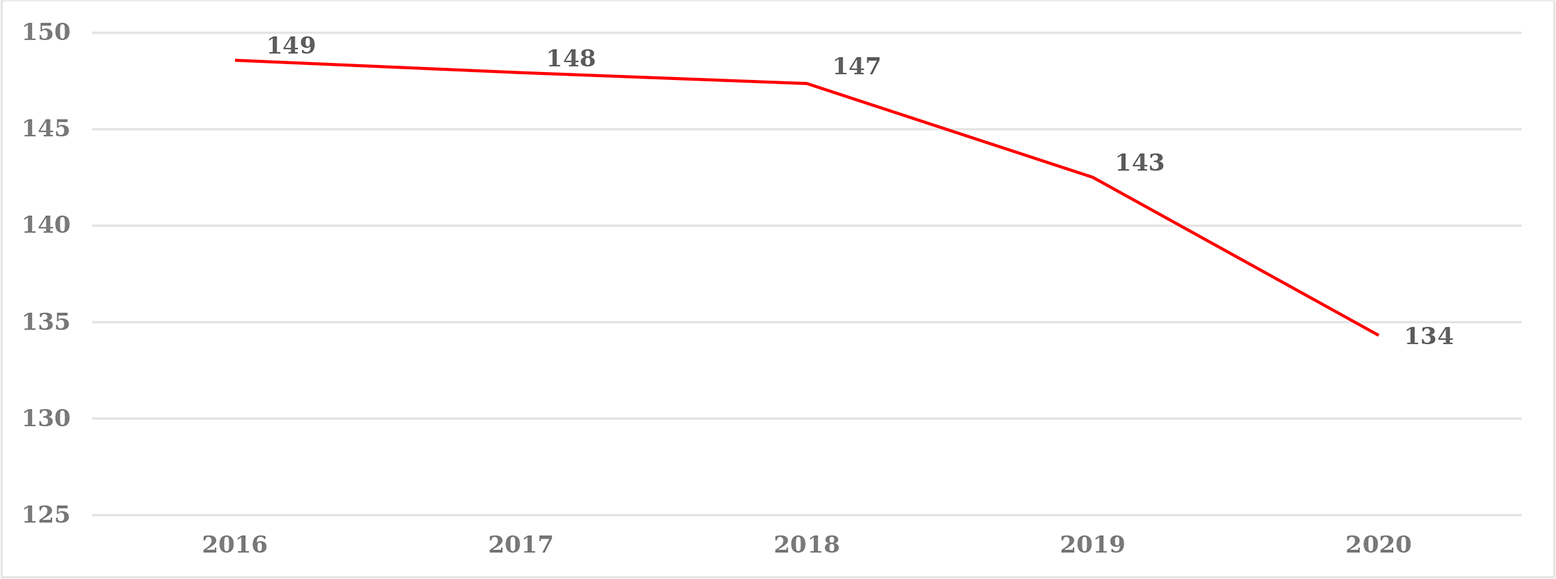
Source: Authors’ own elaboration taken from the Saber Pro Tests
Graph 2 The average of written communication skills of Business Administration programs 2016-2020
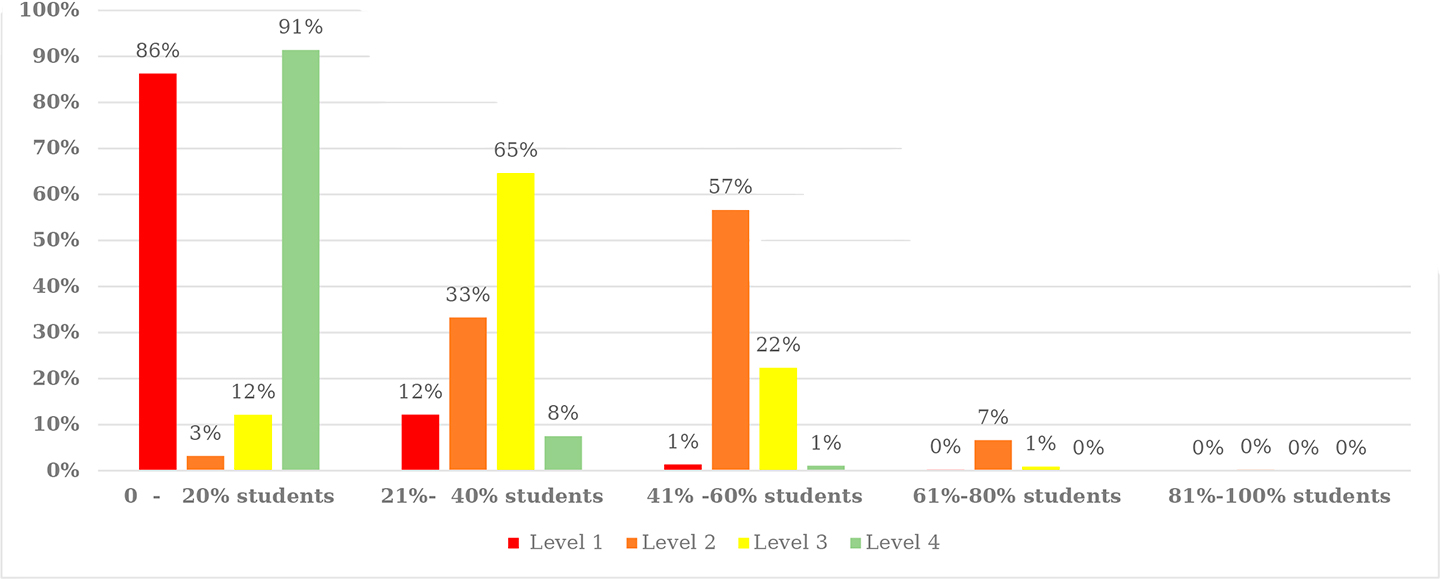
Source: Authors’ own elaboration taken from the Saber Pro Tests
Graph 3 Average performance in written communication skills in the Saber Pro Tests, Business Administration Programs for 2016-2020
The above proposes urgent action by universities to achieve this competence in their students since it is a condition for developing other competencies. In addition, it facilitates the creation, production and transformation of knowledge, which contributes to critical thinking and becomes an indispensable element for professional performance.
However, it is essential to mention that universities are not the only ones responsible for strengthening this competence; it is necessary to coordinate with institutions at other levels of education.
4.1.2. Critical reading.
Critical reading as part of academic literacy becomes an appreciable professional skill. Moreno and Forero (2007) reflect a person’s ability to examine a text in-depth, identifying and interpreting different points of view. From this perspective, the critical reader must be able to interpret data or information that allows him/her to resolve situations and make decisions. In a scenario with much information, a manager must be able to distinguish objective texts and allow him/her to manage information efficiently.
The mean critical reading proficiency in 2020 was 146 points, lower than the average (150 points) and with a standard deviation of 26, indicating that the results were homogeneous among students. From 2016 to 2020, it only increased by one point, from 145 to 146 points (Graph 4).

Source: Authors’ own elaboration taken from the Saber Pro Tests
Graph 4 Average written reading competencies of the Saber Pro Tests, Business Administration Programs 2016-2020 period
Regarding the performance level results, Graph 5 shows that 53% of the academic programs between 41%-60% of the students only reach level 2. 98% of the programs between 0%-20% of the students only reach level 4 (Graph 5).
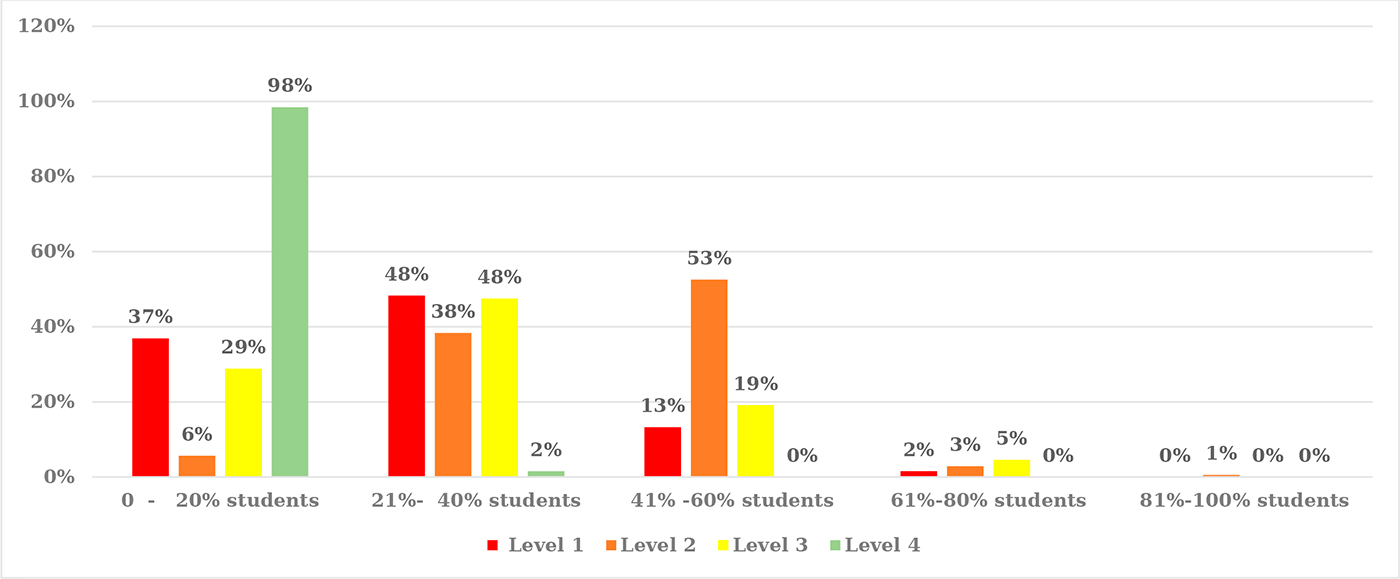
Source: Authors’ own elaboration taken from the Saber Pro Tests
Graph 5 Average student performance in written reading skills in the Saber Pro Tests, Business Administration Programs from 2016-2020
In the statements, Saber Pro evaluates three competencies through two types of texts, continuous and discontinuous, which are no longer than 500 words. Most of the questions correspond to the second and third competencies. Table 2 shows the average of the results of each of the statements concerning critical reading competency. For 2020, students answered more than 40% of the questions incorrectly, especially concerning the third competency, where 54% of the questions were answered erroneously.
Table 2 Average in the statements of the written reading competencies of the Saber Pro Tests, Business Administration Programs period 2016-2020
| Critical Reading Competencies | |||
|---|---|---|---|
| Year | Identify and understand the local contents that conform to a text (%) | Understands how the parts of a text are articulated to give it a global meaning (%) | Reflects on a text and evaluates its content (%) |
| 2016 | 46 | 51 | 48 |
| 2017 | 49 | 46 | 50 |
| 2018 | 45 | 42 | 55 |
| 2019 | 40 | 46 | 57 |
| 2020 | 42 | 43 | 54 |
Source: Authors’ own elaboration taken from the Saber Pro Tests.
Compared to the analysis of the other years, the average remains above this colour, generating a particular concern about the third competency, which evaluates that the student faces the text critically, recognizing strategies and related contents, thus managing the two previous competencies.
The above results should guide efforts at all levels of training to strengthen reading and writing skills that will enable the business administration professional to make assertive decisions.
4.1.3. Quantitative rationing.
Regarding this competence, the Saber Pro tests define it as “the set of elements of mathematics that allow a citizen to take an active and informed part in the social, cultural, political, administrative, economic, educational and labour context” (ICFES, 2017). It is evaluated through three competencies: the first, interpretative and representational, i.e. the ability to understand the representation of quantitative data. The second formulation and execution allow establishing, execution and evaluation of strategies to analyze or solve quantitative information problems. Moreover, the third argumentation is the ability to make judgments through scenarios involving quantitative information.
The scenarios faced by an administrator are tied to numerical or quantitative representations. These allow him/her to make decisions according to the demands of the environment. Training around these competencies allows IHEs to “promote the development of skills to collect, analyze and interpret data in the framework of a problematic situation, as well as the construction and use of mathematical models to solve situations associated with business administration” (Angulo and Vermont, 2018, p. 17). Given the above, it is problematic to confront a reality in which future professionals in Administration present low qualifications in this competency. According to Saber Pro tests, for the year 2020, the average of the programs was 146, with a standard deviation of 26. According to Graph 6, 2018 exceeded the average (150 points) with 156 points, but for 2020 there was a reduction of 10 points. Against the performance level, 32% of the programs between 41%-60% of the students reached level 2, and 27% reached level 3. Very few students (0%-20%) reached level 4 in 99% of the programs (Graph 7).
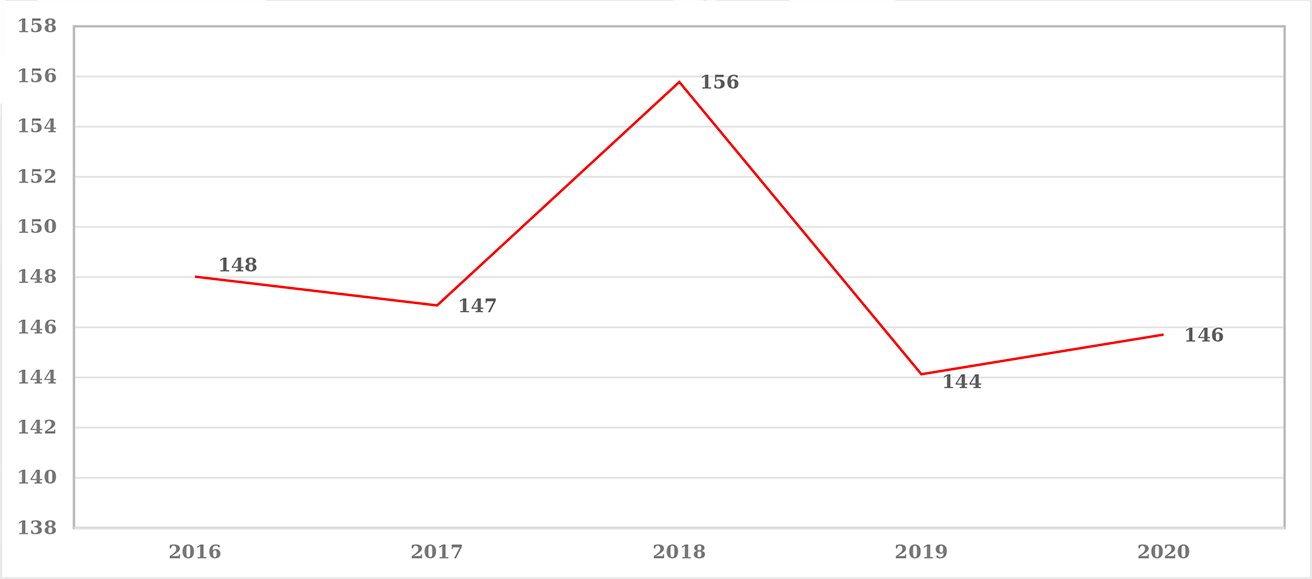
Source: Authors’ own elaboration taken from the Saber Pro Tests
Graph 6 Average quantitative reasoning competencies of the Saber Pro Tests, Business Administration Programs period 2016-2020
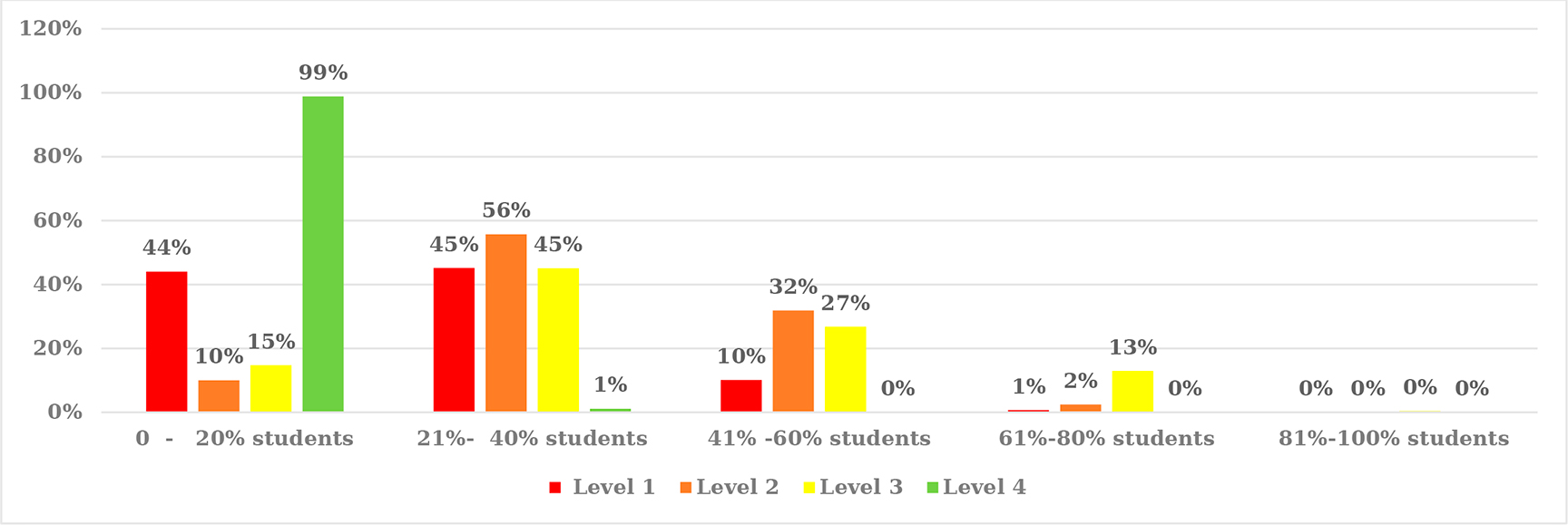
Source: Authors’ own elaboration taken from the Saber Pro Tests
Graph 7 Average student performance in the quantitative reasoning competencies of the Saber Pro Tests, Business Administration Programs for the period 2016-2020
Regarding the statements, Table 3 evidences that since 2016 students, on average, answered more than 41% of the questions wrongly. Competency 1 is above 50% in all years, suggesting that students present weaknesses concerning the argumentation competency. Competence 3 presented an increase from 46% in 2016 to 54% in 2020 in wrong answers. From the interpretation competence, students have lowered their performance.
Table 3 Average of the statements of the Quantitative Reasoning competencies of the Saber Pro Tests, Business Administration Programs period 2016-2020
| Year (%) | Quantitative reasonin | ||
|---|---|---|---|
| 1. Validates mathematical procedures and strategies used to solve problems. | 2. When faced with a problem that involves quantitative information, propose and implement strategies that lead to adequate solutions. | 3. Understands and transforms quantitative and schematic information presented in different formats. | |
| 2016 | 58 | 51 | 44 |
| 2017 | 50 | 50 | 45 |
| 2018 | 54 | 45 | 47 |
| 2019 | 58 | 46 | 46 |
| 2020 | 56 | 46 | 54 |
Source: Authors’ own elaboration taken from the Saber Pro Tests.
The results in this competency propose to generate a reflection from the IHEs towards structural changes regarding training in quantitative reasoning; the articulation with universities with good performance could be a good start to generate actions that strengthen the results of the other IHEs.
4.1.4. Citizenship skills.
The economic, social and political dynamics of globalization and technological progress present new demands for citizenship. Based on this, citizenship education is an effective tool that fosters and enables civic participation in democratic processes, contributing to global challenges such as poverty and inequality (Espínola, 2005).
For the ICFES (2017), the exercise of citizenship goes beyond exercising rights and duties but allows active participation of the individual in the community. Allowing them to reflect on their environment from a social and political approach and propose solutions that promote the welfare of their community. Regarding this concept, Business Administration students in Colombia present a low performance since they are below the average with 147 points (Graph 8). According to Graph 9, the most significant number of students are in levels 2 and 3, and very few reach level 4, meaning that students find it challenging to analyze arguments and statements critically and compare the perspectives of different actors.
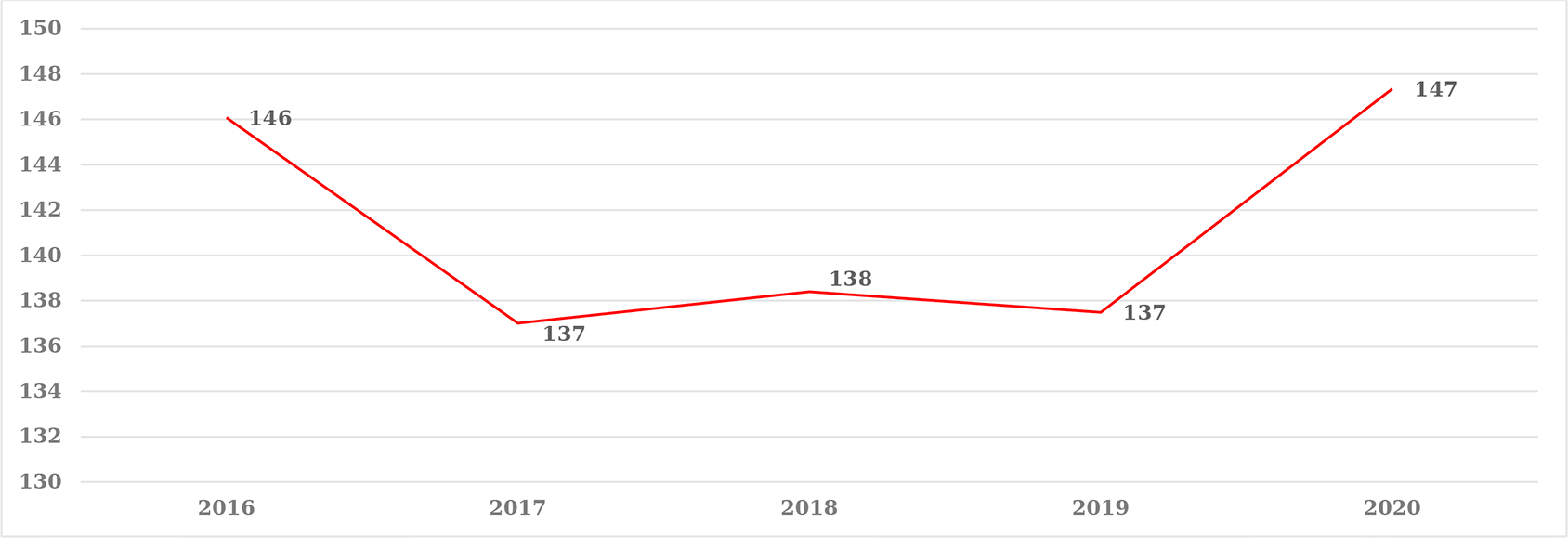
Source: Authors’ own elaboration taken from the Saber Pro Tests
Graph 8 Average of citizenship competencies of the Saber Pro exams. Business Administration Programs 2016-2020 period
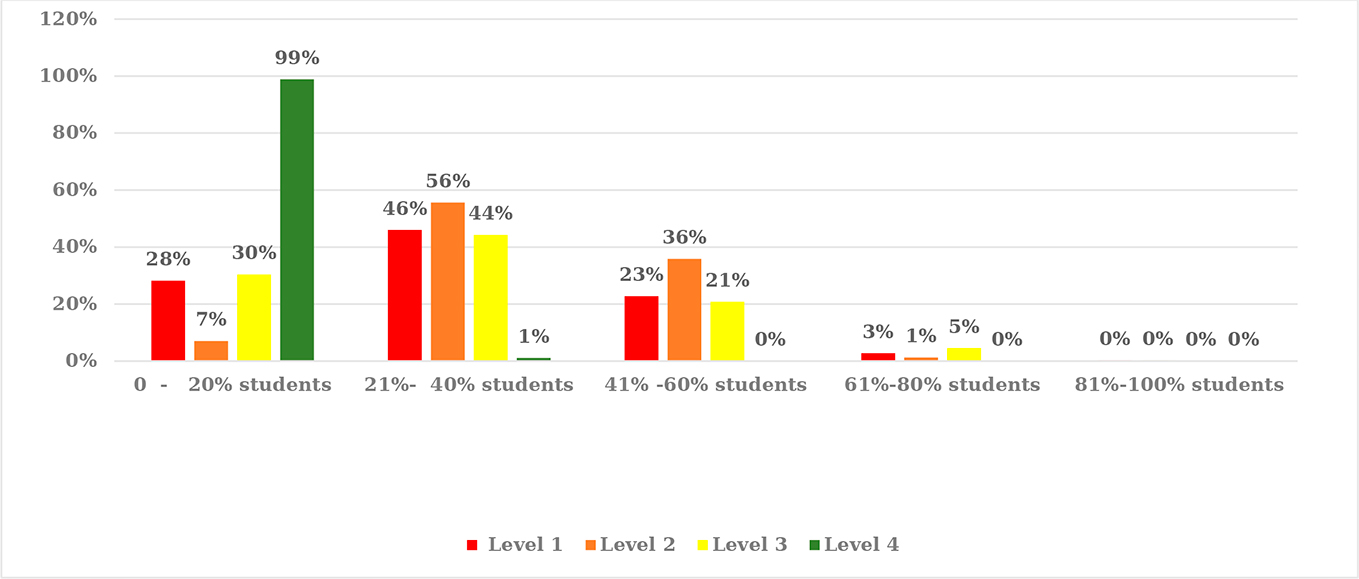
Source: Authors’ own elaboration taken from the Saber Pro Tests
Graph 9 Average Performance of students in citizenship competencies in the Saber Pro Tests, Business Administration Programs in 2016-2020
The answers to the statements evaluated in this competency were wrong on average, between 41% and 70%. For the year 2020, there is a slight improvement since four of the seven competencies obtained the yellow colour (Table 4). Given these results, universities should strengthen the competencies related to understanding the Political Constitution of Colombia, the organization of the State and the existence of different perspectives present in situations where several parties interact.
Table 4 Average of the citizenship competency statements of the Saber Pro Tests, Business Administration Programs
| Competence | 2016 (%) | 2017(%) | 2018(%) | 2019(%) | 2020(%) |
|---|---|---|---|---|---|
| Analyzes and evaluate the relevance and soundness of statements-discourses. | 63 | 46 | 40 | 51 | 35 |
| Understands what the Political Constitution of Colombia is and its fundamental principles. | 47 | 57 | 62 | 61 | 53 |
| Knows the rights and duties enshrined in the Constitution. | 45 | 53 | 42 | 25 | 32 |
| Knows the organization of the State according to the Constitution. | 55 | 52 | 60 | 66 | 51 |
| Recognizes the existence of different perspectives in situations where different parties interact. | 41 | 50 | 47 | 55 | 50 |
| Analyzes the different perspectives present in situations where different parties interact. | 41 | 46 | 47 | 45 | 30 |
| Understands that problems and solutions involve different dimensions and recognize relationships between them. | 41 | 48 | 60 | 58 | 38 |
Source: Authors’ own elaboration taken from the Saber Pro Tests.
4.1.5. English.
In an interconnected society, higher education institutions should prioritise a second language requirement. Therefore, “the linkage of English to the educational curriculum could be conceived as part of the new concerns and demands of globalization; however, this linkage should be conceived as one more element of the integral formation of the student body” (España, 2010, p. 64). Likewise, Romero et al. (2021) suggest that learning should go beyond achieving communication-based interaction processes but should seek skills for managing and developing international transactions.
Faced with this pressure, Business Administration programs face challenges in promoting second language learning among students. The results obtained in this competency have increased slightly in recent years, going from 147 to 153 points, 3 points above the average (Graph 10).

Source: Authors’ own elaboration taken from the Saber Pro Tests
Graph 10 Average of the English competencies of the Saber Pro Tests, Business Administration Programs period 2016-2020
However, their level of performance is low, considering that a large percentage of students are at the A1 and A2 levels. There is even evidence of programs that are in -A1; that is, students do not pass the less complex questions of the test (Graph 11).

Source: Authors’ own elaboration taken from the Saber Pro Tests
Graph 11 Average student performance in the English competencies of the Saber Pro Tests, Business Administration Programs for the period 2016-2020
These results indicate the challenges higher education institutions face regarding English language training. According to Romero et al. (2021) this training should be based on a cooperative and cultural management model for developing management skills based on a second language.
4.2. Specific Competencies
When analyzing the results obtained in the Saber Prose tests, there is evidence of low performance in the specific competencies, especially those related to organizational and financial management. The financial management performance was the lowest, the average was below the average, and in the four years analyzed, it decreased from 147 to 135 points. The same occurs with the management of the organizations, which goes from 154 to 143 points (Graph 12).
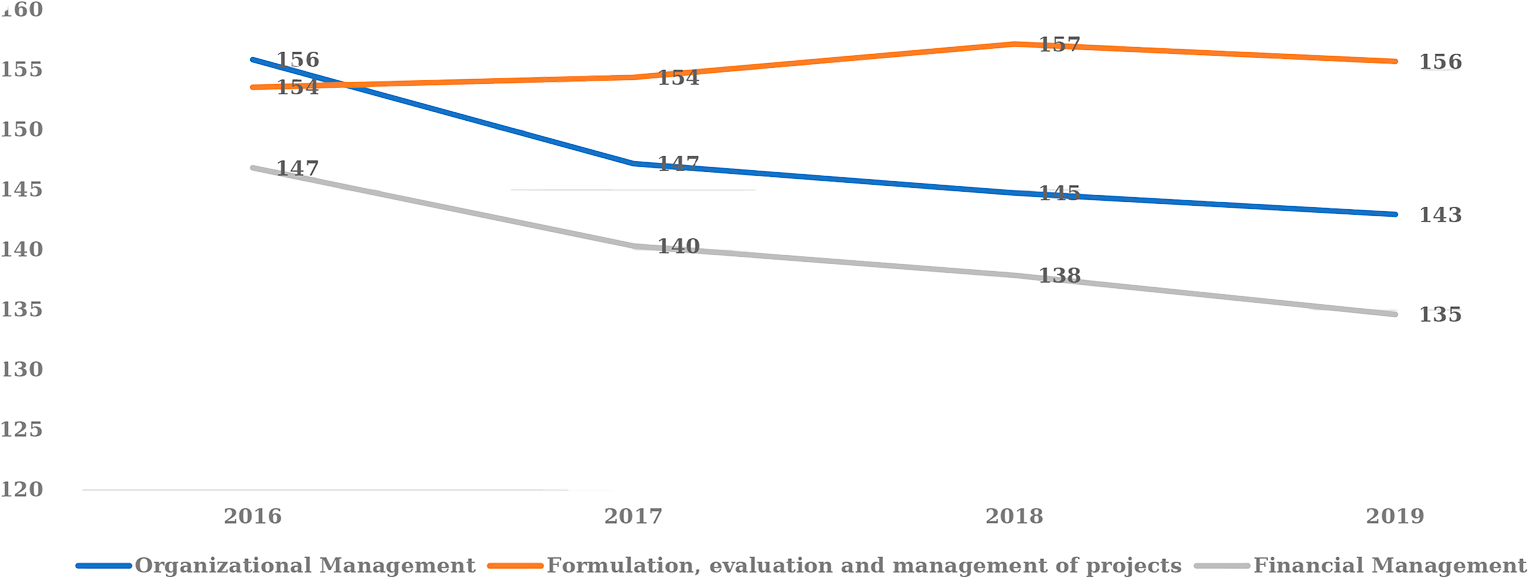
Source: Authors’ own elaboration taken from the Saber Pro Tests
Graph 12 Average of the specific competencies of the Saber Pro Tests, Business Administration Programs period 2016-2020
About the statements (Table 5), the wrong answers are between 41% and 70% (orange colour) for 2020. Although there is a slight improvement compared to previous years, the average number of wrong answers is still above 50%. Concerning the results obtained in the statements of the competency formulation, evaluation and management of projects, they generate an alarm for the competitiveness and development of the country. Due to the role that this competency plays in the productive apparatus of the regions. Given that training in specific competencies is directly related to the work of the professional in business administration, it is of great importance that HEIs promote actions that lead to improving the quality of the program to ensure the timely development of professionals in their environment.
Table 5 Average of the citizenship competency statements of the Saber Pro Tests, Business Administration Programs
| Competence | 2016 (%) | 2017 (%) | 2018 (%) | 2019 (%) | 2020(%) |
|---|---|---|---|---|---|
| Analyzes and evaluate the relevance and soundness of statements-discourses. | 63 | 46 | 40 | 51 | 35 |
| Understands what the Political Constitution of Colombia is and its fundamental principles. | 47 | 57 | 62 | 61 | 53 |
| Knows the rights and duties enshrined in the Constitution. | 45 | 53 | 42 | 25 | 32 |
| Knows the organization of the State according to the Constitution. | 55 | 52 | 60 | 66 | 51 |
| Recognizes the existence of different perspectives in situations where different parties interact. | 41 | 50 | 47 | 55 | 50 |
| Analyzes the different perspectives present in situations where different parties interact. | 41 | 46 | 47 | 45 | 30 |
| Understands that problems and solutions involve different dimensions and recognize relationships between them. | 41 | 48 | 60 | 58 | 38 |
Source: Authors’ own elaboration taken from the Saber Pro Tests.
5. Conclusions
The quality of education is reflected in the development of competencies that students acquire in their training process. Therefore, their evaluation through the Saber Pro tests is fundamental to determining future Business Administrators’ performance. On the other hand, this analysis shows a low performance of the academic programs, which suggests a concern about the role of professionals in the different production scenarios in an increasingly competitive environment.
The low performance in the generic competencies makes the need for the IHEs to strengthen these skills, starting from their capacities and promoting the articulation with institutions of other training levels. Especially when the business administrator is called to be a leader in the organizations that summons his collaborators to reach the objectives under criteria of efficiency, opportunity and integrity.
The performance levels of the generic competencies showed very low results in the competencies of written communication, citizenship competencies and English since it is evident that very few students were able to reach levels 3 and 4. The same panorama is reflected in the statements since in both the generic and specific competencies, the wrong answers exceeded 41% (orange colour); it is only evident that for 2020, the citizenship competencies obtained an improvement since they were in the range of 21-30% (yellow colour). These results alert in IHEs since professionals are not acquiring the essential competencies to develop their role in society.















